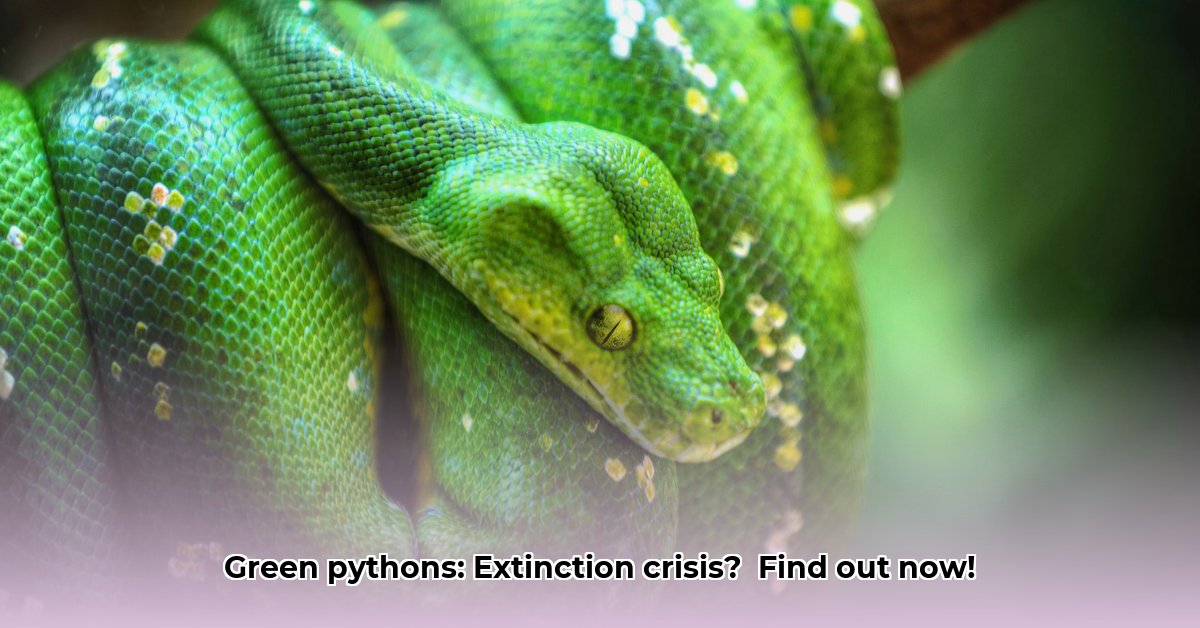The green tree python, a mesmerizing denizen of Australasian rainforests, captivates with its vibrant emerald scales and arboreal grace. This radiant beauty, however, belies a precarious existence, threatened by the insatiable demand of the exotic pet trade. While the IUCN currently lists the species as “Least Concern,” this assessment may mask a more urgent conservation crisis. This article delves into the complexity of the challenges facing the green tree python and explores effective strategies for its long-term survival. For more information on endangered species, see this helpful resource.
The Shadow of Exploitation: Unmasking the Illegal Pet Trade
The illegal trafficking of green tree pythons fuels a lucrative black market, decimating wild populations and undermining conservation efforts. The scale of this illicit trade is alarming, with estimates suggesting thousands of individuals are poached annually. The allure of owning this exotic creature drives relentless demand, creating a relentless cycle of capture and exploitation. This persistent pressure on wild populations necessitates immediate intervention to dismantle smuggling networks and enforce stricter penalties for wildlife trafficking. Furthermore, raising public awareness about the devastating impact of the pet trade is paramount to curbing demand and promoting responsible pet ownership.
Captive Breeding: A Conservation Paradox
Captive breeding programs present a complex duality in the conservation landscape. While offering a potential safety net against extinction by establishing ex-situ populations, they also present inherent challenges. Maintaining genetic diversity within captive populations requires meticulous management, sophisticated breeding strategies, and substantial resources. Without stringent regulations and rigorous oversight, captive breeding initiatives can inadvertently contribute to the illegal pet trade, becoming a source of laundered wild-caught individuals. To realize the true conservation potential of captive breeding, programs must prioritize transparency, adhere to ethical guidelines, and collaborate closely with conservation organizations and research institutions.
Unveiling the Unknown: The Critical Need for Data
A significant obstacle in green tree python conservation is the dearth of reliable population data. Existing estimates are often outdated, based on limited surveys, and fail to capture the dynamic fluctuations in wild populations. This lack of accurate information hinders effective conservation planning and resource allocation. Understanding the distribution, abundance, and population trends of green tree pythons is essential for developing targeted conservation strategies. Investing in comprehensive field research, employing innovative monitoring techniques, and establishing long-term monitoring programs are crucial for bridging this knowledge gap and informing evidence-based conservation decisions.
A Collaborative Imperative: Forging a Path to Preservation
Protecting the green tree python demands a concerted and collaborative approach, uniting governments, researchers, conservation organizations, captive breeders, and pet owners. Strengthening law enforcement, enhancing cross-border collaboration to combat wildlife trafficking, and increasing penalties for illegal trade are essential short-term measures. Long-term conservation success hinges on empowering local communities, promoting sustainable land management practices that protect rainforest habitats, and integrating conservation education into local curricula. Fostering international cooperation, sharing best practices, and supporting research initiatives are vital for advancing our understanding of the species and developing effective conservation strategies.
A Call to Action: Securing the Future of the Green Tree Python
The fate of the green tree python rests on our collective action. Complacency is not an option. We must act decisively to protect this irreplaceable species and the fragile ecosystems it inhabits. Supporting reputable conservation organizations, advocating for stronger wildlife protection policies, and educating ourselves and others about the importance of biodiversity are crucial steps. Each action, no matter how small, contributes to a larger movement for change. We must choose to safeguard this emerald jewel of the rainforest, ensuring its survival for generations to come.
- Revolution Space: Disruptive Ion Propulsion Transforming Satellites - April 24, 2025
- Race Through Space: Fun Family Game for Kids - April 24, 2025
- Unlocking the Universe: reading about stars 6th grade Guide - April 24, 2025




![Saving the [Example of Endangered Species in Pakistan]: A Call to Action for Conservation Efforts example-of-endangered-species-in-pakistan_2](https://www.lolaapp.com/wp-content/uploads/2023/12/example-of-endangered-species-in-pakistan_2-150x150.jpg)











